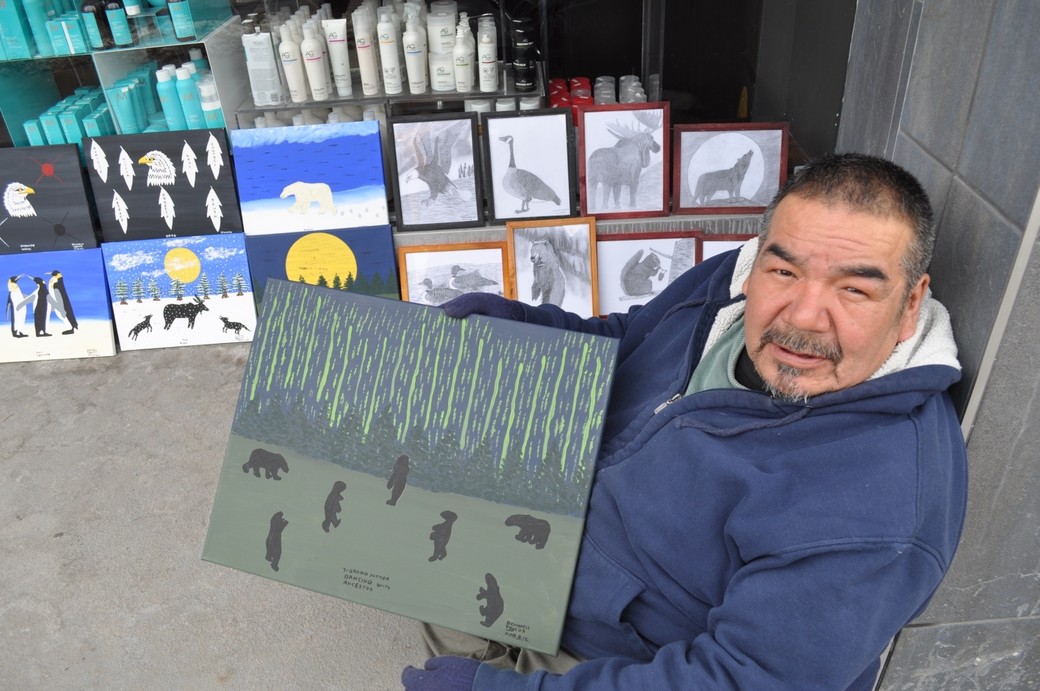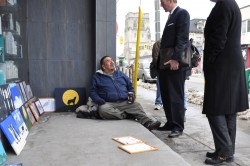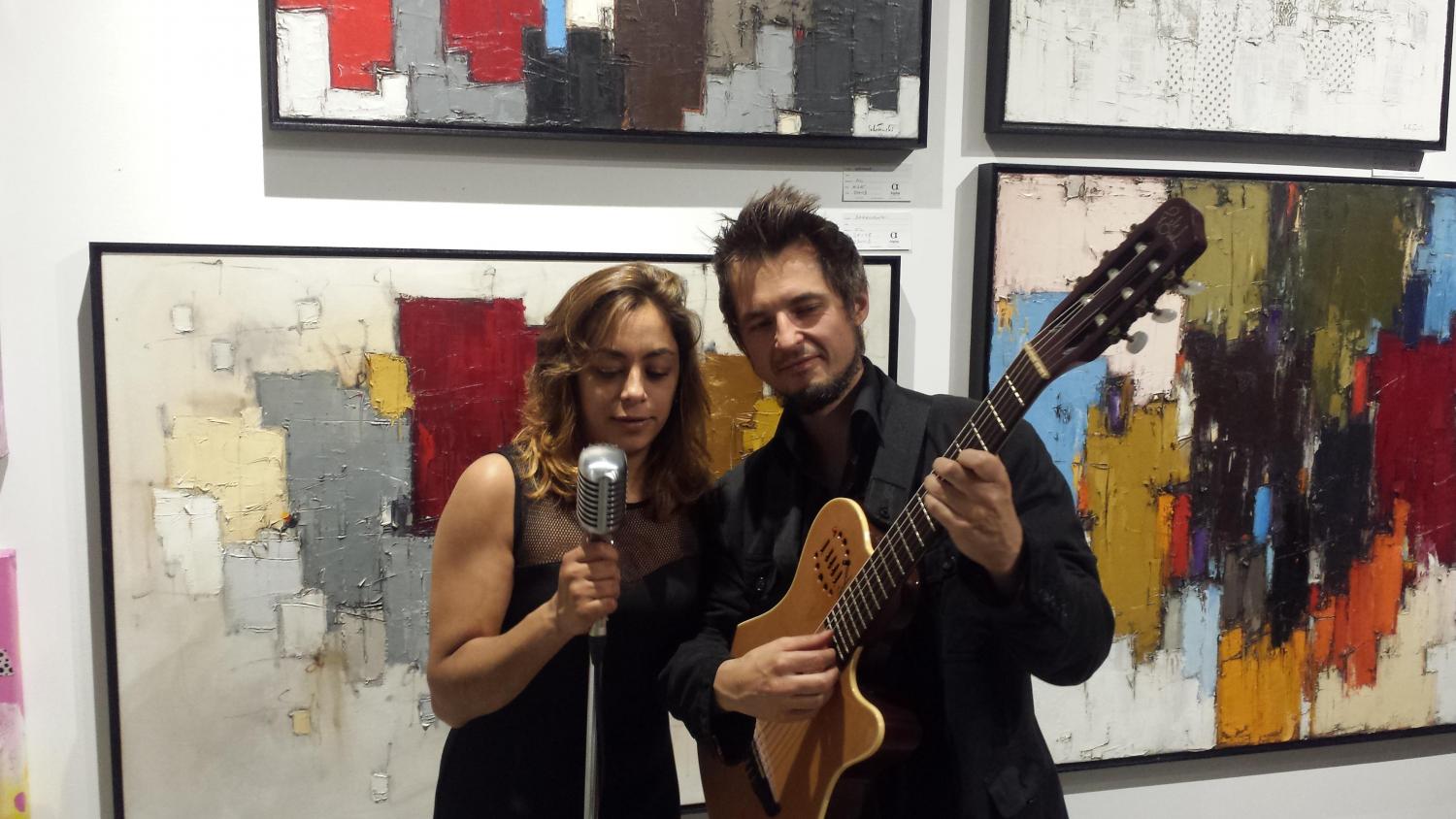
Native Man Celebrates Sobriety with Art
Donnell Taylor of the Constance Lake First Nation paints to seek wisdom of his ancestors to deal with his addiction.
On April 1, 2014, Donnell Taylor set his foot on Ottawa soil. A native man from the Constance Lake First Nation was continuing his “good journey,” which started back in Sudbury, Ontario. After years of drinking and using drugs, he put the bottle down and took up the brush to seek the wisdom of his Aboriginal heritage.
This April, Taylor celebrates a year of being sober by selling his art on the pavements of Elgin Street. In a row of paintings and sketches of bears, eagles and deer, Taylor picks up his favourite one. The drawing, he says, reflects his true nature. Named Dancing with Ancestors, it depicts seven figures, seven sacred truths.
“These are my seven grand-fathers. This is how I try to live my life today: honesty, courage, respect, truth, wisdom, love, humility—this is what I asked for every day,” Taylor says.
Taylor was raised by his grand-parents, who were trappers. He lived with them in remote places until he was 11-years-old, before moving away for the first time to attend school. Taylor stayed at the school for four years, where he turned into a heavy drinker.
After detox and substance abuse treatments, Taylor feels happy and healthy. He is able to rent a small room, buy painting supplies, food and

cigarettes with the money he makes selling art. That’s all he needs in his life. By staying “clean and sober,” he keeps his soul clean, he says.
“Today, I really enjoy my journey,” Taylor says. “I don’t have to worry about anybody looking behind my back, because I know yesterday, I did nothing wrong.”
Unfortunately, his sobriety comes with a price. Six months ago, his mother called him, asking him to come home. He refused. It was not a place to celebrate his sobriety, he says. More than half of the reserve’s population abuse substances.
Taylor has help in Ottawa. He attends support groups, visiting the Wabano Centre for Aboriginal Health and always thanking his coaches and sponsors—everyone who walked along with him on this challenging recovery path. The path that led him back to his native roots and culture.
“Creativity is their inner core identity.”
When it comes to Aboriginal people, dancing, singing, storytelling, painting and other forms of traditional arts are proven to be effective therapeutic methods, says an Ottawa-based psychologist Marianna Shturman. Shturman has been working for over eight years with Aboriginal people, helping them to deal with addictions and mental health problems.
“Creativity is their [indigenous people] inner core identity. The closer they get to their identity, culture, or remember their teachings and who they are, the more healing happens for them,” Shturman says.
Aboriginal people have always been proud and creative people, explains Shturman. The land was integral part to their life. It provided food and healing herbs. They lived off the land, built shelter and sewed their own clothing.
The years of colonial rule, however, stripped them off their lands, culture and identity. Native children were sent to residential schools to get “civilized” under the directive “to kill the Indian in a child.” These measures, Shturman says, destroyed many native communities.
There is a great challenge for Aboriginals to live a traditional way in the modern world, Shturman says. Despite examples of successful Aboriginal people, many try to stay invisible. The belief they are inadequate is deeply entrenched in their psyche, because they were told that they need to change. Stereotypes, racism and negative press don’t help either.
“Ottawa, or non-native places, not necessarily focus on creating place of belonging for everyone, and making them count, and making them visible,” Shturman says. “Visible, not to discriminate against them, but visible to celebrate and value them for who they are, their stories, wisdom and gifts.”
Nourishing gift
As the sun rises above the Ottawa River, Taylor starts a new day by smudging his body and his drawings. It’s a native ritual, where a bundle of herbs are burned to purify and bless people, or places. This way, he pays gratitude and respect for his gift. Never taught how to draw, Taylor always felt he would be pretty good at it. In his culture, he says, everybody has a gift.
“The one thing is that I try not to abuse my art. Because I believe the creator can take that gift away from you as fast as he gave it to you,” Taylor says.
“Today, I don’t even throw a piece of a paper on the ground because I respect mother Earth—something that I’ve never done before. I respect a lot of people. I don’t judge anybody. Today, it’s a better life.”







